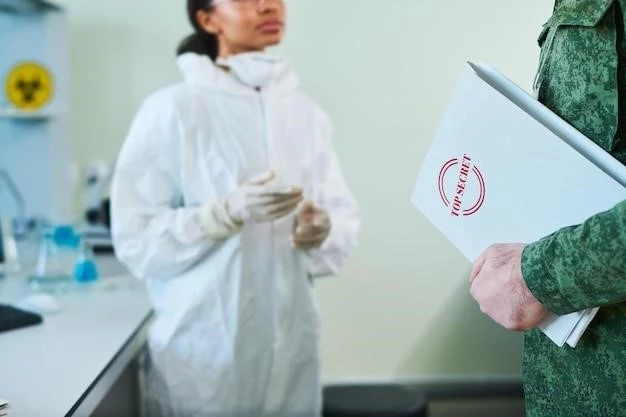Article Plan⁚ Disease, Staphylococcus epidermidis Infection
Introduction to Staphylococcus Epidermidis
Staphylococcus epidermidis, a bacterium commonly found on human skin and mucous membranes, is typically harmless but can pose a threat when it enters the bloodstream through wounds or invasive medical procedures․ This opportunistic pathogen is a leading cause of nosocomial infections, particularly in patients with compromised immunity or implanted medical devices․
Known for its ability to form biofilms on medical devices, S․ epidermidis can trigger infections in various settings, from prosthetic joints to cardiac devices․ Understanding the virulence factors, such as biofilm formation, that contribute to its pathogenicity is crucial in managing and preventing infections caused by this bacterium․
Further research and developments are ongoing to enhance treatment strategies and combat the rising cases of S․ epidermidis infections․ It is essential for healthcare providers to remain vigilant and implement preventive measures to reduce the impact of Staphylococcus epidermidis on patient outcomes․
Causes of Staphylococcus Epidermidis Infection
Staphylococcus epidermidis infections are commonly associated with the implantation of medical devices, such as cardiac devices, orthopedic devices, and CNS shunts․ Patients with implanted devices are at risk, with up to 20% developing infections that manifest as erythema, pain, purulence, and even sepsis․
S․ epidermidis, known for its biofilm-forming ability on plastic devices, poses a significant nosocomial risk․ While generally non-pathogenic, individuals with compromised immune systems are vulnerable․ The bacterium is often a contaminant in clinical samples, emphasizing the importance of infection control measures in healthcare settings․
Understanding the virulence factors of S․ epidermidis, particularly biofilms, is crucial in managing and preventing infections․ Clinicians should remain vigilant, especially in cases involving indwelling medical devices, to minimize the risk of S․ epidermidis-related infections․
Symptoms of Staphylococcus Epidermidis Infection
Staphylococcus epidermidis infections often present with mild symptoms initially, making diagnosis challenging․ Common signs include redness, tenderness, and swelling at the site of infection, which may be mistaken for typical postoperative inflammation․
If left untreated, infections can progress, leading to systemic symptoms such as fever, chills, and malaise․ In more severe cases, where the bacterium enters the bloodstream, symptoms like sepsis, hypotension, and organ dysfunction can occur, necessitating immediate medical attention․
Early detection based on clinical symptoms and prompt laboratory analysis is crucial to prevent complications associated with Staphylococcus epidermidis infections․ Patients with implanted devices or undergoing invasive procedures should be vigilant for any unusual signs and seek medical evaluation promptly․
Diagnosis of Staphylococcus Epidermidis Infection
Diagnosing Staphylococcus epidermidis infections can be challenging due to the bacterium’s subtle symptoms and common presence as a contaminant in clinical samples․ Laboratory analysis, including blood cultures and cultures from infected sites, is essential for accurate diagnosis․
Physicians often look for specific signs such as redness, tenderness, and swelling at infection sites, along with systemic symptoms like fever and malaise in more severe cases․ Special attention should be given to patients with implanted devices, as infections can rapidly progress․
Advanced diagnostic techniques, such as polymerase chain reaction (PCR) testing targeting S․ epidermidis DNA, are also employed in some cases to confirm infections․ Early and precise diagnosis is crucial for initiating appropriate treatment and preventing complications associated with S․ epidermidis infections․
Treatment Options for Staphylococcus Epidermidis Infection
Managing Staphylococcus epidermidis infections typically involves antibiotic therapy․ In cases of mild infection, oral antibiotics like trimethoprim-sulfamethoxazole or doxycycline may be sufficient․ However, for more severe or systemic infections, intravenous antibiotics such as vancomycin or daptomycin are often prescribed․
Due to the bacterium’s propensity for biofilm formation, combination therapy with antibiotics and catheter removal may be necessary for infections related to medical devices․ Surgical intervention to debride infected tissues or remove contaminated devices might also be crucial in certain cases․
Antibiotic susceptibility testing is essential to guide treatment decisions and ensure effective therapy․ Ongoing monitoring of the patient’s response to treatment and potential development of resistance is vital for successful management of Staphylococcus epidermidis infections․
Prevention of Staphylococcus Epidermidis Infection
Preventing Staphylococcus epidermidis infections entails implementing strict infection control measures in healthcare settings․ Proper hand hygiene, sterile techniques during invasive procedures, and adherence to device insertion protocols are crucial to reduce the risk of contamination․
Regular monitoring of patients with implanted medical devices for signs of infection is essential, along with prompt removal of devices when necessary․ Healthcare facilities should prioritize cleaning and disinfection practices to minimize the presence of S․ epidermidis on surfaces and medical equipment․
Additionally, promoting antimicrobial stewardship to prevent unnecessary antibiotic use and selecting appropriate agents based on susceptibility testing can help in combating S․ epidermidis infections effectively․ Education of both healthcare providers and patients on infection prevention strategies plays a vital role in reducing the incidence of these infections․
Impact of Staphylococcus Epidermidis on Medical Devices
Staphylococcus epidermidis exerts a significant impact on medical devices, particularly through biofilm formation․ The ability of S․ epidermidis to adhere to and form biofilms on implanted devices poses a substantial challenge in healthcare settings․
Biofilms created by S․ epidermidis on medical devices serve as protective environments, enabling bacterial colonization and making the infections difficult to treat․ This poses a heightened risk of device-related infections, leading to prolonged hospital stays, increased healthcare costs, and potential complications for patients․
Understanding the mechanisms of biofilm formation and exploring strategies to prevent and eradicate biofilms are essential in mitigating the impact of Staphylococcus epidermidis on medical devices․ Implementing stringent infection control measures and device management protocols are crucial steps in reducing the risk of device-associated infections․
Role of Biofilms in Staphylococcus Epidermidis Infection
Biofilm formation plays a critical role in Staphylococcus epidermidis infections, contributing to the bacterium’s pathogenicity and resistance to antibiotic treatment․ S․ epidermidis’s ability to adhere to surfaces and form biofilms creates a protective environment that enhances its survival and persistence in various settings․
Within biofilms, S․ epidermidis can evade the host’s immune response and conventional antimicrobial therapies, leading to persistent infections and treatment challenges․ The extracellular matrix within biofilms acts as a shield, preventing antibiotics from effectively reaching and eliminating the bacteria․
Developing strategies to disrupt biofilms or prevent their formation is crucial in combating S․ epidermidis infections․ By understanding the role biofilms play in the pathogenesis of S․ epidermidis, healthcare providers can devise targeted approaches to improve treatment outcomes and reduce the incidence of biofilm-related infections․
Staphylococcus Epidermidis in Nosocomial Infections

Staphylococcus epidermidis has emerged as a prominent pathogen in nosocomial infections, especially in healthcare settings․ This opportunistic bacterium poses a significant threat due to its ability to colonize medical devices and cause device-related infections․
Patients with implanted devices, such as catheters or prosthetic joints, are at increased risk of developing S․ epidermidis infections, which can lead to local symptoms at the infection site and potentially progress to bloodstream infections․ The bacterium’s presence in clinical samples underscores the importance of vigilant infection control practices․
Healthcare facilities must prioritize measures to prevent and control S․ epidermidis infections, including strict adherence to sterile protocols during device insertions and enhanced surveillance of high-risk patients․ Understanding the role of S․ epidermidis in nosocomial infections is crucial for implementing effective prevention strategies and reducing healthcare-associated transmission․
Staphylococcus Epidermidis in Endocarditis
Staphylococcus epidermidis plays a significant role in infective endocarditis, particularly affecting prosthetic valves․ The bacterium can cause serious infections in patients with implanted medical devices, leading to complications such as intracardiac abscesses and mortality․
Patients with cardiac devices face a heightened risk of developing endocarditis due to S․ epidermidis contamination, manifesting as symptoms like erythema, pain, and sepsis․ Understanding the association between S․ epidermidis and endocarditis is crucial in diagnosing and managing these potentially life-threatening infections․
Healthcare providers must maintain a high index of suspicion for endocarditis in patients with implanted devices, especially when clinical symptoms suggest S․ epidermidis infection․ Early diagnosis and appropriate treatment are vital in improving outcomes for individuals at risk of endocarditis caused by this opportunistic pathogen․

Comparison of Staphylococcus Epidermidis and Staphylococcus Aureus Infections
Staphylococcus epidermidis and Staphylococcus aureus are both bacteria commonly found on human skin, but they differ in their pathogenicity․ While S․ aureus is known for causing a wide range of infections, including skin and soft tissue infections, pneumonia, and endocarditis, S․ epidermidis is primarily associated with nosocomial infections․
Infections caused by S․ aureus tend to present with more severe symptoms and a higher risk of complications compared to those caused by S․ epidermidis․ S․ aureus infections are often more aggressive and require prompt and aggressive treatment to prevent serious consequences․
Understanding the differences in the pathogenic potential of these two bacteria is crucial in clinical practice․ Healthcare providers must tailor their diagnostic and treatment approaches based on the specific characteristics of S․ epidermidis and S․ aureus infections to ensure optimal patient outcomes․
Research and Developments in Treating Staphylococcus Epidermidis Infection
Recent research has focused on developing innovative approaches to treat Staphylococcus epidermidis infections, particularly those associated with medical devices․ Novel antimicrobial coatings for implants have shown promising results in reducing bacterial adhesion and biofilm formation․
Furthermore, researchers are exploring the use of bacteriophages as targeted therapies to combat S․ epidermidis infections, potentially offering specific and efficient eradication of the bacterium․ Enhanced diagnostic techniques, including rapid molecular tests, are being developed to enable quicker identification of S․ epidermidis in clinical specimens․
Continued investments in understanding the mechanisms of S․ epidermidis pathogenicity and exploring alternative treatment modalities are essential for addressing the challenges posed by these infections․ Collaborative efforts between researchers, healthcare providers, and pharmaceutical companies are key to driving advancements in the management of Staphylococcus epidermidis infections․
Case Studies and Real-Life Examples of Staphylococcus Epidermidis Infections
In a recent case study, a patient with a cardiac device developed Staphylococcus epidermidis infection, presenting with signs of erythema, pain, and sepsis around the device site․ The infection required prompt diagnosis and treatment to prevent further complications․
Another real-life example involved a prosthetic joint infection caused by S․ epidermidis, highlighting the challenges posed by biofilm-forming bacteria․ The patient exhibited persistent symptoms despite antibiotic therapy, emphasizing the importance of targeted treatment strategies․
These cases underscore the clinical impact of Staphylococcus epidermidis infections and the complexities involved in managing such infections, especially in individuals with implanted devices․ Healthcare providers must remain vigilant and proactive in diagnosing and treating S․ epidermidis infections to optimize patient outcomes․
Conclusion and Future Outlook for Managing Staphylococcus Epidermidis Infections
In conclusion, the management of Staphylococcus epidermidis infections requires a multifaceted approach involving infection control, early diagnosis, and targeted treatment strategies․ With the bacterium’s propensity for biofilm formation and its association with medical device-related infections, vigilance and proactive measures are vital․
Looking ahead, future developments in treating S․ epidermidis infections focus on innovative therapies, such as antimicrobial coatings for implants and bacteriophage-based treatments․ Advanced diagnostic tools and enhanced understanding of S․ epidermidis pathogenicity will continue to shape treatment protocols․
As the healthcare industry evolves, collaboration between researchers, clinicians, and industry partners will be key in advancing the management of Staphylococcus epidermidis infections․ By staying abreast of emerging research and technologies, healthcare professionals can better navigate the challenges posed by these infections and improve patient outcomes․
